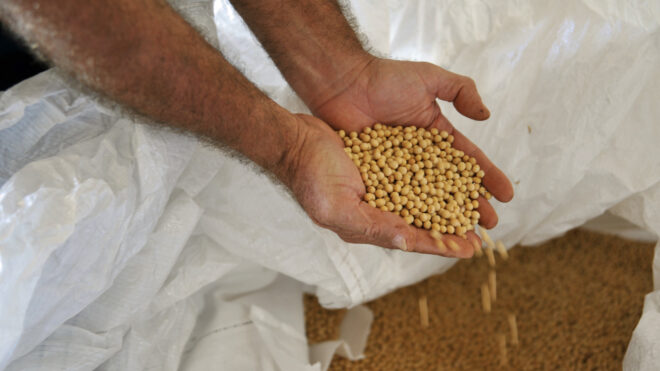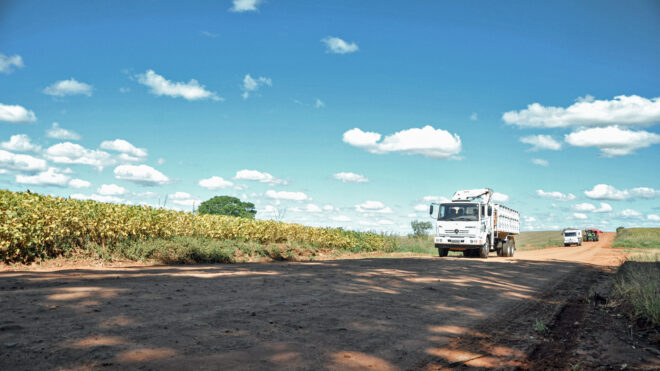Farmer Rogério Pacheco is bent over amongst his soya plants. With a knife he pokes into the red soil as the sun burns on his straw hat. “Look!” he proudly points. “Just like I said: The soil is teeming with life.” Two worms snake across each other and try to find a way through withered plant material.
He grabs a handful of plant residues. “This is our humus.” Then he points to the half-rotted maize stalks, remnants of the previous crop. “We haven’t ploughed since 1991. It caused erosion. During torrential rains the soil was washed down from the hills and took our crops with it. By not ploughing we maintain the structure of the soil and the soil organisms remain intact. In addition, this also improves the water-retention capacity of the soil. I dare say that direct sowing is the salvation of Brazilian agriculture. “
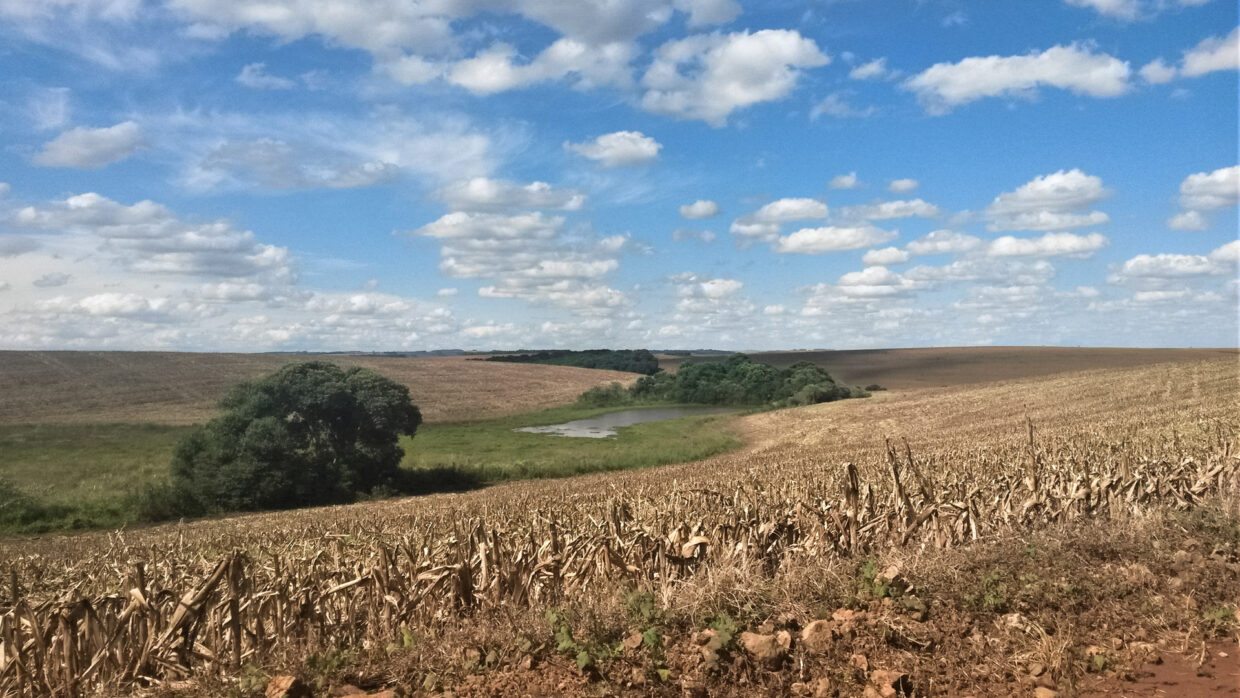
Brazil is well known for its vast soya fields. The country is about 8.5m km2. About 9% of the surface is used for agriculture.
Mr Pacheco has an arable farm in the southern state of Rio Grande do Sul, some 1,000km south of São Paulo, the largest city in Brazil. He has 1,000ha of land, of which 800ha is arable land and 200ha is uncultivated. He is the third generation in the family business and is happy to take the lead. For the past 10 years his focus has been on precision farming. He regularly takes soil samples, measures maize yields during combining, uses satellite data to visualise and assess his land and collaborates with a local machine manufacturer when it comes to testing precision techniques.
His entire business is focused on improving soil quality. His crop choices are based on this: He grows oats to improve subsequent soya rooting in the rotation. Prior to planting maize, he grows sorghum or wild peas as a green manure. Its straw supplies nitrogen. “That produces 90kg/ha of pure nitrogen for my own use. I only spread potash when the soil sample says it’s necessary and phosphate as required. If necessary, I scatter lime after harvest.”
By not ploughing we maintain the structure of the soil and the soil organisms remain intact.
Rogério Pacheco
Over the past five years in particular, he has noticed that more and more companies are engaged in precision farming. “Previously, the required knowledge and suitable machinery were not available: Soil samples were taken haphazardly, and GPS was too inaccurate. If we still intend to farm here in 50 years’ time, we will have to focus on improving soil quality. ”
Focus on precision farming
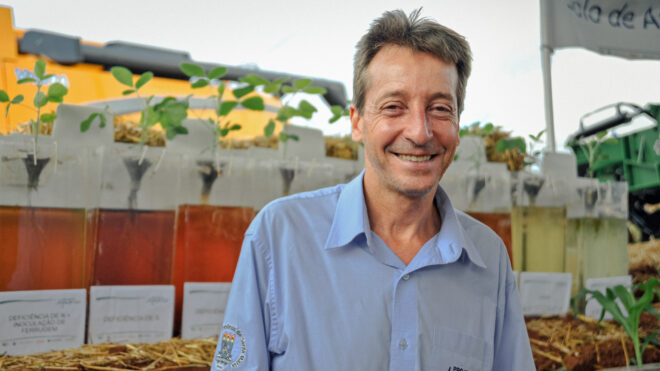
Professor Telmo Jorge Carneiro Amado: “We initially focused on reducing nitrogen use, now we are focused on the whole picture.”
Mr Pacheco is not the only one who understands this. As a member of the farmers’ co-operative Cotrijal, he is closely involved with the latest developments. In Não-me-toque, the city also known as the capital of Brazilian precision farming, this co-operative works closely with the University of Santa Maria and a local machine manufacturer, as part of the Aquarius project.
The aim is to raise Brazilian precision farming to a higher level. “In 2001 our university was the first in Brazil to collect soil data,” says Professor Telmo Jorge Carneiro Amado. “That went pixel by pixel with soil sensors. The satellites and drones came later. They allow monitoring the field during the vegetation period.
“We initially focused on reducing nitrogen use, now we are focused on the whole picture. After all, Brazil is the largest consumer of artificial fertiliser in the world, so if we can refine precision farming, the advantages will be enormous.”
The principal investigator adds: “The Brazilian soil suffers everywhere from a shortage of phosphate and potassium. Artificial fertiliser (NPK) is easily available and ensures a high crop yield. But Brazilian farmers are trying to save money, they buy fungicides, but forget to invest in nutrients. They need to learn to look at the entire soil system. We need to bring our knowledge to those farmers.”
That works to a certain degree. The use of pesticides is declining, and soil maps show that the soil is more uniform and generates more revenue than 10 years ago, according to Mr Amado.
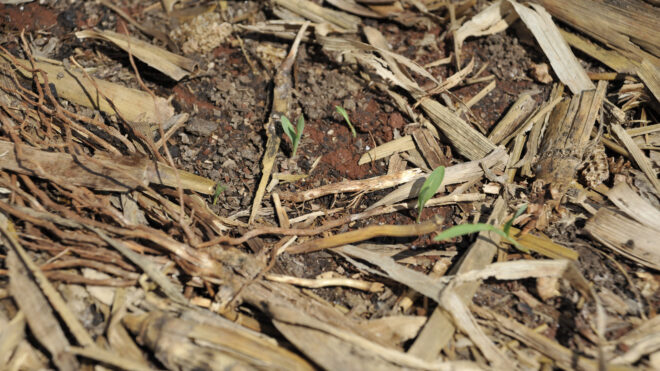
By not ploughing the soil life increases. The presence of earthworms is the evidence of that.
But that does not mean the sector can rest on its laurels. Although the members of the co-operative are already convinced of the advantages of a healthy soil and are immersing themselves in precision farming, a large section of Brazilian farmers are sceptical. “They are primarily focused on the short term,” says Mr Amado. They go for cash crops and only think of profit. They think that depleting the soil in this way is of secondary importance. That´s really a shame. They use the argument that their grandfather never worked with yield maps and soil analyses, so why should they,” sighs the professor. “Fortunately, the younger generation of farmers are more open to it. That generation is much more digitally orientated and sees the added value of it.”
Nevertheless, in a vast country like Brazil it is precisely that digital aspect which remains an obstacle to be surmounted. “The poor internet coverage leads to problems. The connection between the machine on the farm and the office is sometimes lost.”
Looking after the soil
Agricultural engineer and farmer Francisco Souilljee studied precision farming for years. He measures yields during the maize harvest and has his soil analysed. He bases his fertiliser program on yield maps, and every 10 days he receives satellite images of his land.
As early as 1995 he decided to not plough and rather sow his crops without disturbing the surface. He carried out various tests on his 700ha of land, including the use of vetch as a catch crop. “By using vetch my fertiliser demand was greatly reduced. For example, with maize we can have two harvests and I now only need to spread 150kg/ha of nitrogen per crop instead of 400kg per year previously. It is a natural form of fertiliser. We must first look after the soil properly. Only then can we focus on higher yields.”
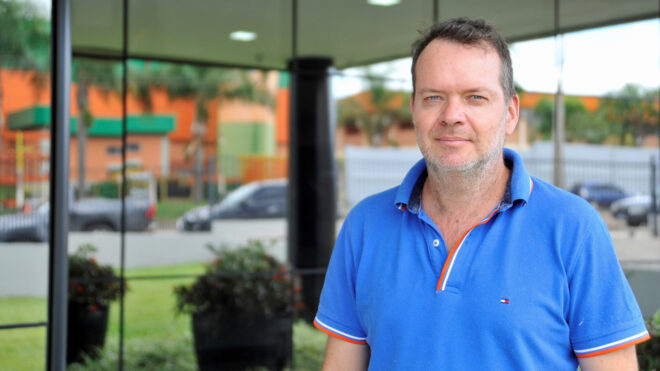
Agricultural engineer and farmer Francisco Souilljee studied precision farming for years.
Mr Souilljee’s grows oats, maize and soya, and produces 12t/ha of maize: “In the US, the yield can be higher, and we should be able to reach that level too.” With soya, he achieves 5.8t/ha, but believes that 7t is possible if it is grown within a crop rotation. “Precision farming is one thing, but there is a limit to what is profitable and what is not. You can invest more and more, but that also increases your risk. Therefore, crop rotation is very important to reduce risk and it leads to higher yields too.”
He knows monoculture is a problem. “Many farmers grow cash crops, but do not see what that does to the soil in the longer term. They sell the land again when the yields decrease.”
In addition, corruption is still a major issue. Seed traders mix bad and good quality seed and sell it at high prices as ‘good’ seed. “As a farmer, you only notice it when your crop hardly grows. These are additional challenges that farmers have to deal with here.”
Convincing numbers
Mr Pacheco has now returned to his office. If he has a good internet connection, he can see exactly what is happening on his farm at that moment, and where his machines are. “This is really the future,” he points out. “Since I started precision farming and paying more attention to crop rotation, I have demonstrably higher yields.”
Since I started precision farming and paying more attention to crop rotation, I have demonstrably higher yields.
Rogério Pacheco
He first produced 3.9t/ha of soya, now it´s 5.1t. His maize yield has more than doubled: From 7.2t/ha to 15.0t. “I really owe that higher yield to three things: Direct drilling, a broad crop rotation and precision farming,” he says. “I hope to be able to convince more Brazilian farmers with these figures, because if we want to continue to offer cheap food to the entire world, technical and genetic improvements are necessary.”
Brazil in a nutshell
Brazil is, with 8.5m km2, the largest country in South America. It has a population of 208m people (2017). About 9% of the surface area of Brazil is used for agricultural purposes. 23% of the labour force works in agriculture. Brasilia is the capital, but São Paulo is the largest city in the country with over 12m inhabitants. The official language is Portuguese.
Brazil has the largest economy in Latin America. The country has highly developed agricultural, mining, industrial and service sectors. It has an abundance of natural resources such as oil and iron ore.
The prevailing climate is tropical maritime. In the North it is primarily a tropical rainforest climate, with high average temperatures of more than 26°C.
Agriculture
Brazil is the world’s largest producer and exporter of coffee. It also produces a lot of citrus fruits (especially oranges), sugar cane, soyabeans, rice, grain, cocoa, cotton, tobacco and bananas.
Cattle, pigs and sheep are the most numerous livestock, and timber is also important. 45% of the total export revenue originates from the agricultural sector.
Agriculture in Brazil is in partly well developed, but improvements can still be made. Agricultural production in Brazil is expected to increase in the coming years, as millions of hectares of land are still available for cultivation. Due to the climate, several crops can take place per year.


